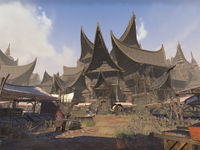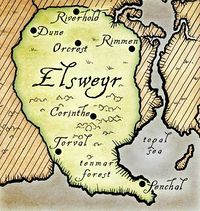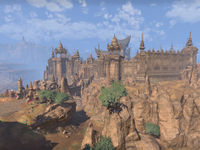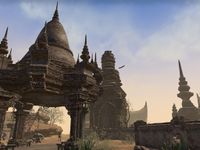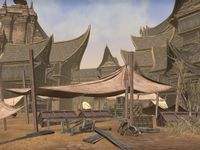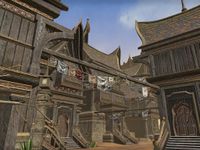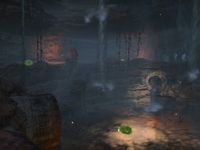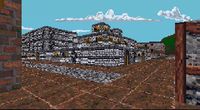Lore:Orcrest
| Orcrest | |
|---|---|
| Type | Settlement |
| Continent | Tamriel |
| Province | Elsweyr |
| Region | Anequina (The Scar) |
| Appears in | Arena, ESO |
Orcrest (/ˈɔːr.krɛst/ orr-crest) is one of the eight major cities in the province of Elsweyr,[1] situated on the barren canyons of Anequina. Orcrest is known as the center of commerce in Northern Elsweyr, built atop a plateau that overlooks the harsh desert of the Scar, with ancient walls and great bridges across the canyon.[2] Orcrest was one of the original sixteen kingdoms of Elsweyr, known for their rogues and thieves.[3]
Layout & Geography[edit]
The city-state of Orcrest is found in the center of northern Elsweyr, a part of the greater region of Anequina, which is known for its harsh badlands, and its arid plains.[4][5] There is an exclamation in Elsweyr, "Dust of Orcrest".[6] Orcrest is situated on a large plateau that overlooks the lower basin of the Scar. The upper level that surrounds the city is where the main road is found, and contains very few dangers, whereas the lower level is filled with all sorts of deadly creatures, such as the Harpies and Terror Birds, but also dead Khajiit that have fallen into the Scar. Orcrest is a heavily walled-off, yet restricted city divided into two districts. The western half of Orcrest is known as the market district or the lower city. From the city gates, the market-place is sprawled across the square, with tons of stalls formed into circles. It is no surprise that Orcrest has such an expansive bazaar considering its status as a center of commerce in Anequina. East of these markets is the narrow streets and alleyways of the town that eventually lead into the upper city. The southern street-alley is known as Red Senche Alley. In this halfway point, the city is built around a somewhat tall mountain. The lower half surrounds it. and some buildings also jut out of it, towering over the alleys. The sewer system, which is built in the city plateau, is connected throughout the lower city and meets in the middle, underneath the mountain. The upper city is much more liberating than the lower half, filled with open-air parks and whirling short walls. The largest building, which may be the town hall, is found directly on the eastern wall, where it overlooks the entire city.[7] Orcrest is neighbored by several settlements, including Kings Walk to the northeast, and Neumar Walk to the southwest.[1]
History[edit]
Orcrest stood as one of the sixteen kingdoms of ancient Elsweyr that were active throughout the Merethic Era and the late First Era. Feudal hunt-lords and a cruel hunter-aristocracy ruled the sixteen kingdoms in the Merethic Era. In the waning years of the era, the hunt-lords of Meirvale and Helkarn were in conflict with each other, to the point where they drafted thousands of their peasants into their conflict. This action caused one of the worst famines in Elsweyr's history, and after three years of this war, the peasants rebelled against their hunt-lords, inspiring other peasant uprisings in the neighboring kingdoms, including Orcrest.[8] Like the other kingdoms, the Kingdom of Orcrest was devastated by the arrival of the Thrassian Plague in 1E 2260. What remained of Orcrest was absorbed into the Kingdom of Anequina.[9][10]
When King Keirgo of Anequina married Queen Eshita of Pellitine in 2E 309, Keirgo's Orcrest Honor Guard, atop their White Lions, were present in the ceremony.[11]
At a point before Ranser's War, a then-mercenary Kurog gro-Bagrakh stayed at a seedy tavern in Orcrest and met Zephrine Frey, a Covenant spy. In 2E 560, the Knahaten Flu began to spread across southern Tamriel, and heavily afflict Elsweyr. It had begun in Senchal and eventually spread into Alabaster, where it contaminated the entire province. Orcrest was one of the many cities in Elsweyr to be affected by the Knahaten Flu,[12] it was, in fact, the city in Northern Elsweyr that was dealt the hardest deal. But this was not the last of their problems. Throughout the middle sixth century of the Second Era, the northern lands of Elsweyr were invaded by the Empire of Cyrodiil. Using the outbreak of the flu to their advantage, the Imperial Legion invaded Anequina and annexed the cities of Orcrest and Riverhold. The Khajiit warrior, General Namu led a squadron in the campaign to retake both cities, but perished in the attack.[13] But the plague continued to rage across Northern Elsweyr, and so various people attempted to quell the flu. The master alchemist of Dune, Ubraz and his entourage were sent to control the disease in Orcrest in 2E 565, but failed in the attempt.[14][15]
Orcrest's situation did not change in the next couple of decades, and by around 2E 582, Orcrest was in a state of chaotic ruin with no sight of any outside help. The market district was ransacked and burned to ashes. The upper city was devoid of life and depressing. The very few people that lived in Orcrest had descended into utter madness, deranged by the disease that they managed to live with, or the paranoia of being surrounded by the sickened. Some people had even resorted to cannibalism to stay alive in the city or destroy any resemblance of life that approaches them. At this time, a couple of Peryite cultist had delved into Orcrest to seek proof that the Daedric Prince had wiped out the city with the Knahaten Flu. They managed to escape the city with their lives.[16]
Cherim was a famous Khajiiti tapestry maker who lived in Orcrest during the late Third Era. At the height of his success he had four factories creating replicas of his works and his originals were sold for extraordinary prices. Cherim's Heart of Anequina records his interview with Livillus Perus, where he discussed one of his first tapestries, the Heart of Anequina, depicting Cherim's involvement in the Heart of Anequina during the Five Year War.[17]
During the Imperial Simulacrum in the late Third Era, the city-state of Orcrest was an active settlement, being ruled by King Amtaba. It had a rivalry with Riverhold.[18]
Gallery[edit]
Notes[edit]
- Arena was originally conceived as a fighting game featuring a tournament that took the player to each of Tamriel's cities to challenge different gladiatorial teams. According to a file from that stage of development left behind in the final game, Orcrest's gladiatorial team would have been called "the Silent Ones".[UOL 1]
References[edit]
- ^ a b Map of Elsweyr – The Elder Scrolls: Arena
- ^ Guide to Northern Elsweyr — Infrasia Mallius
- ^ The Sixteen Kingdoms
- ^ Map of Elsweyr — Pocket Guide to the Empire (1st Edition)
- ^ Pocket Guide to the Empire, 1st Edition: The Elsweyr Confederacy — Imperial Geographical Society, 2E 864
- ^ Exclamations in the Elder Scrolls: Arena — The Imperial Library
- ^ Map of Orcrest — The Elder Scrolls Online: Elsweyr
- ^ Origins of the Khajiiti Martial Tradition — Tendwuayne, Sapiarch of Foreign Customs
- ^ Pocket Guide to the Empire, 3rd Edition: Sugar and Blood: the Cats of the South — Imperial Geographical Society, 3E 432
- ^ Anequina and Pellitine: An Introduction — Sulema, Initiate Scholar of the Pa'alatiin
- ^ The description of the White Lion in ESO
- ^ The Eagle and the Cat — Lord Gharesh-ri, Speaker for the Mane
- ^ Khali's dialogue in ESO
- ^ Shazah's dialogue in ESO
- ^ Shazah's Diary — Shazah
- ^ Unhealthy Preoccupation quest in ESO: Elsweyr
- ^ Cherim's Heart of Anequina — Livillus Perus, Professor at the Imperial University
- ^ Orcrest location and rumors in Arena
Note: The following references are considered to be unofficial sources. They are included to round off this article and may not be authoritative or conclusive.
